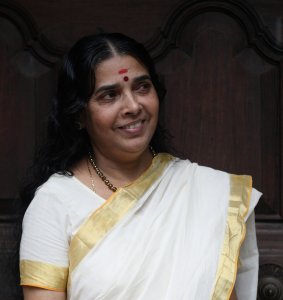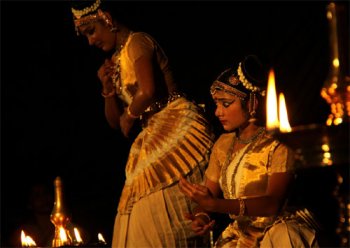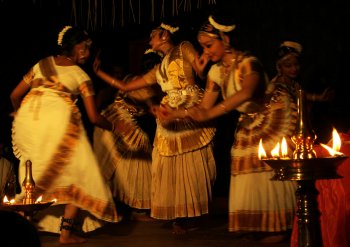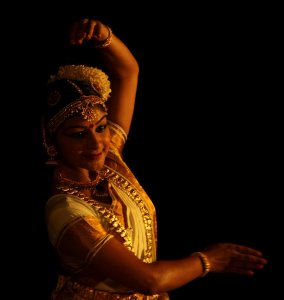
|   |

|   |
Making a mission of teaching Mohiniattam - Renu Ramanath e-mail: renuramanath@hotmail.com Photos: Manoj Parameswaran June 24, 2013 Teaching Mohiniattam had been nothing short of a mission for Nirmala Paniker, disciple of none other than Kalamandalam Kalyanikutti Amma, the doyen of the dance form that was resuscitated during the 30s and 40s.  “My attempt is to evolve a proper methodology for the teaching of the dance form,” says Nirmala, for whom teaching and researching dance has been a life-long passion. Trained at RLV College of Music and Fine Arts, Tripunithura, Nirmala had taken to a teaching career at a young age, along with researching into the ancient dance and theatre traditions of Kerala. She had been deeply involved in the activities of Natana Kairali, and Ammannur Chachu Chakyar Smaraka Gurukulam that carried on the work of resuscitating the classical theatre of Koodiyattam and Nangiarkoothu. Though she used to give advance training classes to students who were already dancers during her holidays, it was in 2000 that Natanakaisiki was founded, following her decision to quit the job, devoting full time to teaching and researching on dance. At Natanakaisiki, importance is given to the Meisadhakam, the body exercises, as part of making the body conducive to carry the expressions through movements. ‘Rangaparichayam,’ a festival of Mohiniattam by the students of Natanakaisiki was held at Madhava Natya Bhoomi of Ammannur Gurukulam, at Irinjalakuda recently. All the students at Natanakaisiki, including the seven year old tiny tots who are just beginning their journey into the world of dance as well as the senior students who have already performed in important festivals in south India, presented their talent.  The two day event covered all the items in the traditional repertoire of Mohiniattam, right from the Ganapathi Sthuthi, Devi Sthuthi, the sudhanritha portions of cholketu and jatiswaram, varnam, kirtanam and saptham. Kurathi, one of the five Desi Nritta-s that were part of the ancient repertoire of Mohiniattam revived by Nirmala Paniker after extensive research was also performed. Keiko Okano, who hails from Japan, and who has been training under Nirmala Paniker for four years, presented ‘Kurathi’ narrating the story of Lord Ayyappa. The song beginning with “Mayam Kurathi njaane” was an old one, with the missing lyrics added by Kavalam Narayana Panikker. The most significant work of the two-day festival was the Saptham, literally the Seventh One, the last item presented on the second day based on a poem by the well-known Malayalam poet ONV Kurup. Choreographed by Nirmala Paniker, it narrated the story of the princess Madhavi, daughter of King Yayati, who was given by her father to the sage Galava as an object to be pledged off to various kings for collecting 800 rare white horses as gurudakshina. Both the young sage, in his ardent wish to fulfill the promise of gurudakshina and the king, in his obstinate wish to maintain the image of the most generous one who never refuses any request from anyone, had not seen the travails through which Madhavi was put through. In return for the rare white horses, Madhavi had to spend one year with each king and bear him a son whom she had to abandon at the moment of birth itself.  In ONV’s poem, Madhavi, after being returned by Galava to her father on completing summons all the kings at the behest of her father for a swayamvara near a verdant forest and after recalling the humiliations meted out to her by the men, she rejects the world of men and walks away into the forest. Sandra Pisharody and Parvathy Sreevallabhan, senior students of Natanakaisiki, presented the item with Greeshma Suresh, Sudharma Periyath and Keiko Okano joining in the last part. The choreography had focussed on the pangs of pain experienced by Madhavi as she was forcibly separated from four babies successively, for fulfilling Galava’s promise to his guru. Another important piece was the Siva Sthuthi, presented by Parvathy Sreevallabhan on the first day of the festival. Composed and choreographed by Nirmala Paniker, this varnam beginning with “Natana nipuna Viswanatham bhaje hum” narrated two stories lauding the divine greatness of Siva. Parvathy effortlessly portrayed the story of Kamadahana and of his drinking deadly venom, Kalakootam. An interesting part of abhinaya in this item was Parvathy’s subtle and appropriate portayal of bheebhatsam, a rasa rarely found in the repertoire of Mohiniattam, while depicting Siva’s reaction on drinking Kalakoota.  Another varnam, also composed and choreographed by Nirmala Panikker and presented by Sandra Pisharody, narrated a story about Sita’s drawing the portrait of Ravana, and how that led to the tragic turn of her life. Sandra, 17, and Parvathy, 16, are the senior most students of Natanakaisiki with 12 and 10 years of training behind them. Even at this young age, they have already performed extensively including in the important dance festivals in south India including the Soorya Festival, Thiruvananthapuram, Mohini Nrithyathi Festival of Kerala Sangeetha Nataka Akademi, Thrissur and Aayirathandu Vizha at Thanjavur. The other students of Natanakaisiki including Chaithanya Nandanan, Hridaya Haridas, Anupama Shaji, Sreelakshmi, Gayatri Menon and Rudrapriya also joined in the other items. At Natanakaisiki, the training starts with meisadhakam in the first year. The students are introduced to some basic steps (chuvadu-s) from Thiruvathirakkali. Basic training in Thiruvathirakkali is also given at this stage. This part of the training aims at developing a lasya culture into the body of the young dancers as Thiruvathirakkali is the form that stays closest to Mohiniattam. Only after this step the adavu-s are introduced. A combination of the adavu-s which were initially codified by Kalamandalam Kalyanikutti Amma and later at Kerala Kalamandalam, are part of the training here. The initial codification of adavu-s and the first-ever attempt to structuralise Mohiniattam were the contributions of Kalyanikutti Amma. Nirmala Paniker, while training her disciples, concentrates on the aspects of abhinaya, as she believes in the tradition of Virali-s, the dancers who had the ability to create bhava with ‘the eye that is body,’ (entire body) stead of face alone. “It is an attempt to bring back the lost glory of abhinaya in Kerala’s female dance tradition,” she points out. She firmly believes in the antiquity of Kerala’s female dance tradition, quoting the ancient texts such as Silappathikaram which makes many references to female dancers and different forms and techniques of dances. It is also pointed out that when the poet Tagore watched Kalyani Amma’s performance, he was impressed by her abhinaya. The students at Natanakaisiki are taught the mudra-s combined with abhinaya, with the help of sloka-s. Knowledge of Sanskrit is necessary for the complete understanding of the sloka-s, and most of the students also learn Sanskrit either at home or from school. “It is said that when a good dancer expresses grief, tears should shine in her eyes; of course she is not expected to cry, only that the tears should come! And, when expressing anger, the face should turn red.” Nirmala Panikker says that she is always inspired and guided by the lessons in abhinaya that she had learnt from the great doyen of Koodiyattam, Guru Ammannur Madhava Chakyar himself. Renu Ramanath is an independent journalist and columnist based in Kochi. A former staff reporter of The Hindu (Kochi) she specializes in visual and performing art forms, architecture and related subjects. |